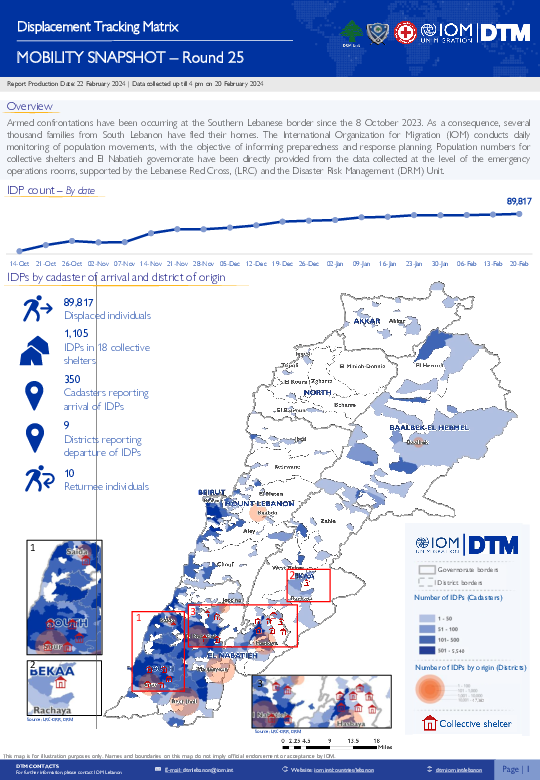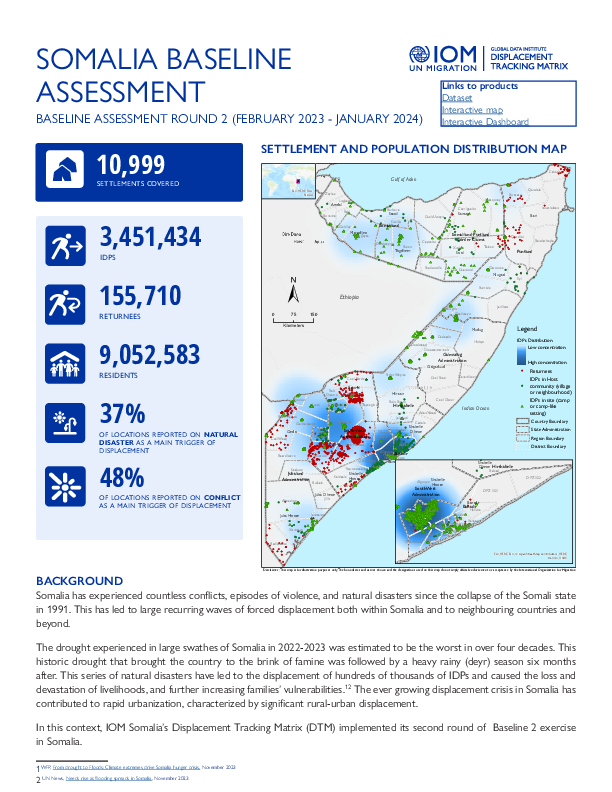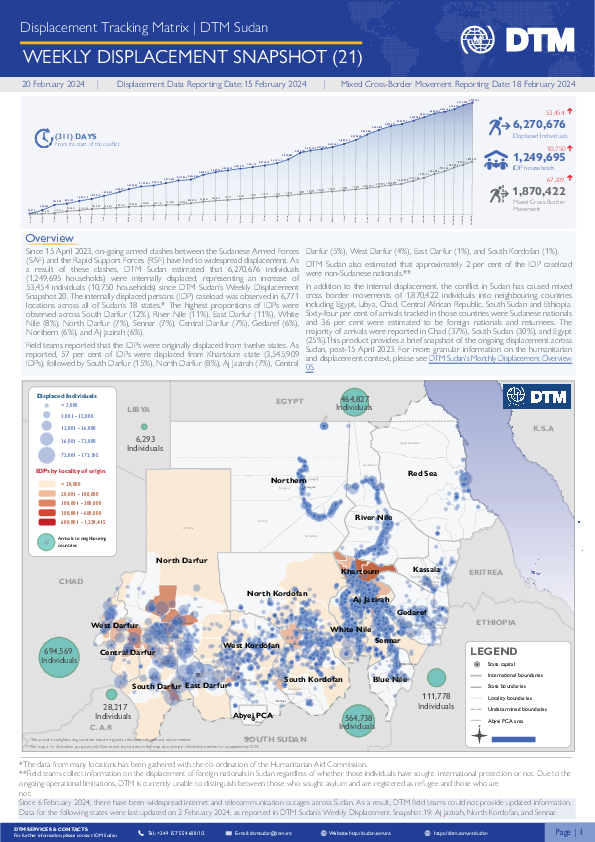-
Countries
-
Data and Analysis
-
Special Focus
-
Crisis Responses
Baseline Assessment

Contact
dtmlebanon@iom.int
Language
English
Location
Lebanon
Period Covered
Oct 10 2023
Feb 20 2024
Activity
- Mobility Tracking
- Baseline Assessment
Since October 8 there has been an increase in cross-border incidents between Israel and Lebanon, resulting in the displacement of people both within the South and elsewhere within the country. Since October 10, the Displacement Tracking Matrix (DTM) has been conducting the daily monitoring of population movements. The objective of the exercise is to inform preparedness and response planning.

Contact
DTM Libya, DTMLibya@iom.int
Language
English
Location
Libya
Period Covered
Oct 01 2023
Dec 31 2023
Activity
- Flow Monitoring
- Mobility Tracking
- Baseline Assessment
This infographic presents the key findings of Round 50 of the mobility tracking and flow monitoring components of the Displacement Tracking Matrix (DTM) programme in Libya.

Contact
DTM Libya, DTMLibya@iom.int
Language
English
Location
Libya
Period Covered
Oct 01 2023
Dec 30 2023
Activity
- Flow Monitoring
- Migrants presence
- Mobility Tracking
- Baseline Assessment
IOM Libya’s Displacement Tracking Matrix (DTM) programme identified a total of 706,509 migrants from 45 nationalities in the 100 Libyan municipalities during round 50 of data collection (October - December 2023). The number of migrants in Libya increased slightly compared to the previous round of data collection (from 697,532 migrants, round 49 to 706,509 migrants, round 50).
Despite improvement in the overall migrant unemployment rate, around half of female migrants continue to be unemployed and actively seeking work (49%) — more than three times the percentage of males (14%). At the same time, financial issues continue to be the main difficulties faced by the majority of migrants, regardless of sex or age. DTM Libya data further shows that economic constraints are the main obstacle impeding migrants’ access to essential services including healthcare, clean drinking water and education for their children.
Contact
dtmlibya@iom.int
Location
Libya
Activity
- Mobility Tracking
- Baseline Assessment
Period Covered
Oct 01 2023 -Dec 31 2023
Libya Migrants baseline assessment
Population Groups
Migrants Present
Survey Methodology
Unit of Analysis Or Observation
Admin Area 3
Admin Area 4
Type of Survey or Assessment
Key Informant
Keywords
Geographical Scope Full Coverage
Administrative boundaries with available data
The current dataset covers the following administrative boundaries
Contact
DTM Sudan, DTMSudan@iom.int
Location
Sudan
Activity
- Mobility Tracking
- Baseline Assessment
Period Covered
Apr 15 2021 -Feb 14 2024
- DTM Sudan estimates that 6,270,676 Individuals (1,249,695 Households) were recently internally displaced.
- The IDP caseload was observed in 6,771 locations across all of Sudan’s 18 states.
- The highest proportions of IDPs were observed across South Darfur (12%), River Nile (11%), East Darfur (11%), White Nile (8%), North Darfur (7%), Sennar (7%), Central Darfur (7%), Gedaref (6%), Northern (6%), and Aj Jazirah (6%).
- Field teams reported that the IDPs were originally displaced from twelve states. As reported, 57% per cent of IDPs were displaced from Khartoum state (3,545,909 IDPs), followed by South Darfur (15%), North Darfur (8%), Aj Jazirah (7%), Central Darfur (5%), West Darfur (4%), East Darfur (1%), and South Kordofan (1%).
- IOM-DTM also reported that an estimated 1,870,422 mixed cross-border movements were made into neighbouring countries.
- This product provides brief insights into those displaced in Sudan post-15 April 2023. For more granular information on the IDP caseload and the displacement context, please see IOM-DTM's Monthly Displacement Overview (05).
A more detailed version of this dataset is available, to get access kindly click on the 'Request Access' button
Population Groups
IDPs
Survey Methodology
Unit of Analysis Or Observation
Site or Location
Type of Survey or Assessment
Key Informant
Keywords
Geographical Scope Partial Coverage
Administrative boundaries with available data
The current dataset covers the following administrative boundaries

Contact
DTM Somalia, IOMSomaliaDTM@iom.int
Language
English
Location
Somalia
Period Covered
Feb 01 2023
Jan 31 2024
Activity
- Mobility Tracking
- Baseline Assessment
Baseline 2, an area-based assessment, is the second step of Mobility Tracking implemented at settlement level and aims to quantify presence of population categories.
As of January 2024, DTM Somalia has mapped around 3,451,434 IDPs, 155,710 returnees and 9,052,583 residents across 17 regions and 10,999 assessed locations. IDPs were present in 45 per cent of locations assessed (4,611 locations) and returnees were present in eleven per cent of assessed locations (1,204 locations)
The results include regions of origins, reasons for displacement and accessibility information, as well as the Operational Zones (OPZ) established by OCHA. These zones are designed to support sub-district response and reporting efforts.

Contact
DTM Sudan; dtmsudan@iom.int
Language
English
Location
Sudan
Period Covered
Feb 08 2024
Feb 14 2024
Activity
- Mobility Tracking
- Baseline Assessment
Overview
From 15 April 2023, armed clashes erupted between the Sudanese Armed Forces (SAF) and the Rapid Support Forces (RSF) in multiple cities across Sudan. Clashes initially took place in cities across Northern and Khartoum states, later spreading across the Darfur and Kordofan regions.
Highlights
- DTM Sudan estimates that 6,270,676 Individuals (1,249,695 Households) were recently internally displaced.
- The IDP caseload was observed in 6,771 locations across all of Sudan’s 18 states.
- The highest proportions of IDPs were observed across South Darfur (12%), River Nile (11%), East Darfur (11%), White Nile (8%), North Darfur (7%), Sennar (7%), Central Darfur (7%), Gedaref (6%), Northern (6%), and Aj Jazirah (6%).
- Field teams reported that the IDPs were originally displaced from twelve states. As reported, 57% per cent of IDPs were displaced from Khartoum state (3,545,909 IDPs), followed by South Darfur (15%), North Darfur (8%), Aj Jazirah (7%), Central Darfur (5%), West Darfur (4%), East Darfur (1%), and South Kordofan (1%).
- IOM-DTM also reported that an estimated 1,870,422 mixed cross-border movements were made into neighbouring countries.
- This product provides brief insights into those displaced in Sudan post-15 April 2023. For more granular information on the IDP caseload and the displacement context, please see IOM-DTM's Monthly Displacement Overview (05).
Contact
IOM Somalia DTM iomsomaliadtm@iom.int
Location
Somalia
Activity
- Mobility Tracking
- Baseline Assessment
Period Covered
Feb 01 2023 -Jan 31 2024
Baseline 2, an area-based assessment, is the second step of Mobility Tracking implemented at settlement level and aims to quantify presence of population categories.
As of January 2024, DTM Somalia has mapped around 3,451,434 IDPs, 155,710 returnees and 9,052,583 residents across 17 regions and 10,999 assessed locations. IDPs were present in 45 per cent of locations assessed (4,611 locations) and returnees were present in eleven per cent of assessed locations (1,204 locations)
The results include regions of origins, reasons for displacement and accessibility information, as well as the Operational Zones (OPZ) established by OCHA. These zones are designed to support sub-district response and reporting efforts.
Population Groups
IDPs
Residents
Returnee (Previously Internally Displaced)
Survey Methodology
Unit of Analysis Or Observation
Admin Area 2
Admin Area 3
Admin Area 4
Community
Household
Individual
Site
Site or Location
Type of Survey or Assessment
Key Informant
Keywords
Geographical Scope Full Coverage
Administrative boundaries with available data
The current dataset covers the following administrative boundaries
Contact
dtmlebanon@iom.int
Location
Lebanon
Activity
- Mobility Tracking
- Baseline Assessment
Period Covered
Oct 10 2023 -Feb 13 2024
Since October 8 there has been an increase in cross-border incidents between Israel and Lebanon, resulting in the displacement of people both within the South and elsewhere within the country. Since October 10, the Displacement Tracking Matrix (DTM) has been conducting the daily monitoring of population movements. The objective of the exercise is to inform preparedness and response planning.
Aggregated data is available through the DTM API: https://dtm.iom.int/data-and-analysis/dtm-api
A more detailed version of this dataset is available, to get access kindly click on the 'Request Access' button
Population Groups
IDPs
Survey Methodology
Unit of Analysis Or Observation
Admin Area 2
Admin Area 3
Type of Survey or Assessment
Key Informant
Keywords
Geographical Scope Full Coverage
Administrative boundaries with available data
The current dataset covers the following administrative boundaries
Pagination
- Previous page
- Page 42
- Next page
